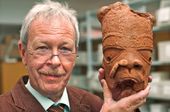
© NASA/JPL/Space Science InstituteThe kidney-shaped feature in this image of Titan's south polar region is Ontario Lacus, which is thought to be filled with liquid hydrocarbons
The largest lake on Saturn's moon Titan is as smooth as a mirror, varying in height by less than 3 millimetres, a new study shows. The find, based on new radar observations, adds to a deluge of evidence that the moon's lakes are indeed filled with liquid, rather than dried mud.
"Unless you actually poured concrete and spread it really, really smoothly, you'd never see something like that on Earth," says team member Howard Zebker of Stanford University.
Astronomers have waffled on whether Saturn's largest moon is dry or wet, but the bulk of the evidence points to liquid lakes.
The radar on the Cassini spacecraft, which arrived at Saturn in 2004, turned up dark splotches at Titan's poles. The darkness in radar indicates those regions are very smooth, like the signal expected from the surface of a liquid lake.



